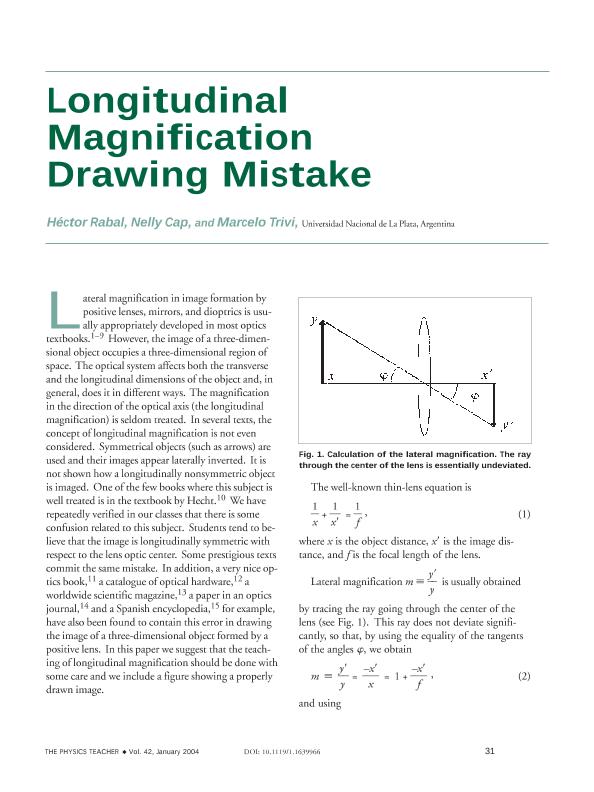Mostrar el registro sencillo del ítem
dc.contributor.author
Rabal, Hector Jorge

dc.contributor.author
Cap, Nelly Lucía

dc.contributor.author
Trivi, Marcelo Ricardo

dc.date.available
2020-04-14T19:14:06Z
dc.date.issued
2004-01
dc.identifier.citation
Rabal, Hector Jorge; Cap, Nelly Lucía; Trivi, Marcelo Ricardo; Longitudinal Magnification Drawing Mistake; American Association of Physics Teachers; The Physics Teacher; 42; 1; 1-2004; 31-33
dc.identifier.issn
0031-921X
dc.identifier.uri
http://hdl.handle.net/11336/102514
dc.description.abstract
Lateral magnification in image formation by positive lenses, mirrors, and dioptrics is usually appropriately developed in most optics textbooks.1–9 However, the image of a three-dimensional object occupies a three-dimensional region of space. The optical system affects both the transverse and the longitudinal dimensions of the object and, in general, does it in different ways. The magnification in the direction of the optical axis (the longitudinal magnification) is seldom treated. In several texts, the concept of longitudinal magnification is not even considered. Symmetrical objects (such as arrows) are used and their images appear laterally inverted. It is not shown how a longitudinally nonsymmetric object is imaged. One of the few books where this subject is well treated is in the textbook by Hecht.10 We have repeatedly verified in our classes that there is some confusion related to this subject. Students tend to believe that the image is longitudinally symmetric with respect to the lens optic center. Some prestigious texts commit the same mistake. In addition, a very nice optics book,11 a catalogue of optical hardware,12 a worldwide scientific magazine,13 a paper in an optics journal,14 and a Spanish encyclopedia,15 for example, have also been found to contain this error in drawing the image of a three-dimensional object formed by a positive lens. In this paper we suggest that the teaching of longitudinal magnification should be done with some care and we include a figure showing a properly drawn image.
dc.format
application/pdf
dc.language.iso
eng
dc.publisher
American Association of Physics Teachers

dc.relation
Corrección en https://doi.org/10.1119/1.1664374
dc.rights
info:eu-repo/semantics/openAccess
dc.rights.uri
https://creativecommons.org/licenses/by-nc-sa/2.5/ar/
dc.subject
OPTICAL EDUCATION
dc.subject.classification
Óptica

dc.subject.classification
Ciencias Físicas

dc.subject.classification
CIENCIAS NATURALES Y EXACTAS

dc.title
Longitudinal Magnification Drawing Mistake
dc.type
info:eu-repo/semantics/article
dc.type
info:ar-repo/semantics/artículo
dc.type
info:eu-repo/semantics/publishedVersion
dc.date.updated
2020-03-16T15:06:39Z
dc.journal.volume
42
dc.journal.number
1
dc.journal.pagination
31-33
dc.journal.pais
Estados Unidos

dc.description.fil
Fil: Rabal, Hector Jorge. Consejo Nacional de Investigaciones Científicas y Técnicas. Centro Científico Tecnológico Conicet - La Plata. Centro de Investigaciones Ópticas. Provincia de Buenos Aires. Gobernación. Comisión de Investigaciones Científicas. Centro de Investigaciones Ópticas. Universidad Nacional de La Plata. Centro de Investigaciones Ópticas; Argentina. Universidad Nacional de La Plata; Argentina
dc.description.fil
Fil: Cap, Nelly Lucía. Universidad Nacional de La Plata; Argentina
dc.description.fil
Fil: Trivi, Marcelo Ricardo. Universidad Nacional de La Plata; Argentina
dc.journal.title
The Physics Teacher

dc.relation.alternativeid
info:eu-repo/semantics/altIdentifier/doi/http://dx.doi.org/10.1119/1.1639966
dc.relation.alternativeid
info:eu-repo/semantics/altIdentifier/url/https://aapt.scitation.org/doi/10.1119/1.1639966
Archivos asociados
